Related Research Articles

Arizona Territory, colloquially referred to as Confederate Arizona, was an organized incorporated territory of the Confederate States that existed from August 1, 1861 to May 26, 1865, when the Confederate States Army Trans-Mississippi Department, commanded by General Edmund Kirby Smith, surrendered at Shreveport, Louisiana. However, after the Battle of Glorieta Pass, the Confederates had to retreat from the territory, and by July 1862, effective Confederate control of the territory had ended. Delegates to the secession convention had voted in March 1861 to secede from the New Mexico Territory and the Union, and seek to join the Confederacy. It consisted of the portion of the New Mexico Territory south of the 34th parallel, including parts of the modern states of New Mexico and Arizona. The capital was Mesilla, along the southern border. The breakaway region overlapped Arizona Territory, established by the Union government in February 1863.
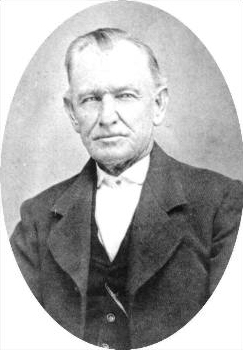
Henry Eustace McCulloch was a soldier in the Texas Revolution, a Texas Ranger, and a brigadier general in the army of the Confederate States during the American Civil War.
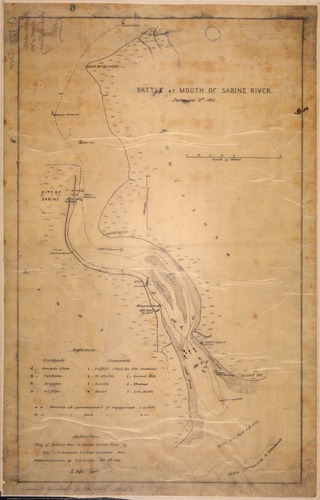
The Second Battle of Sabine Pass was a failed Union Army attempt to invade the Confederate state of Texas during the American Civil War. The Union Navy supported the effort and lost three gunboats during the battle, two captured and one destroyed.
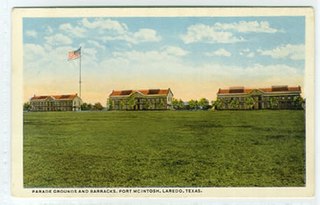
Fort McIntosh was a U.S. Army base in Laredo, Webb County, Texas, from 1849 to 1946.

California's involvement in the American Civil War included sending gold east to support the war effort, recruiting volunteer combat units to replace regular U.S. Army units sent east, in the area west of the Rocky Mountains, maintaining and building numerous camps and fortifications, suppressing secessionist activity and securing the New Mexico Territory against the Confederacy. The State of California did not send its units east, but many citizens traveled east and joined the Union Army there, some of whom became famous.

The siege of Fort Pulaski concluded with the Battle of Fort Pulaski fought April 10–11, 1862, during the American Civil War. Union forces on Tybee Island and naval operations conducted a 112-day siege, then captured the Confederate-held Fort Pulaski after a 30-hour bombardment. The siege and battle are important for innovative use of rifled guns which made existing coastal defenses obsolete. The Union initiated large-scale amphibious operations under fire.
This is a list of Confederate government Civil War military units, not raised by any state.
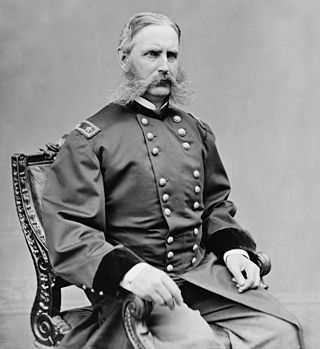
Christopher Columbus Augur was an American military officer, most noted for his role in the American Civil War. Although less well known than other Union commanders, he was nonetheless considered an able battlefield commander.

Zenas Randall Bliss was an officer and general in the United States Army and a recipient of the Medal of Honor. He formed the first unit of Seminole-Negro Indian Scouts, and his detailed memoirs chronicled life on the Texas frontier. He was the father of Rhode Island Lieutenant Governor Zenas Work Bliss.
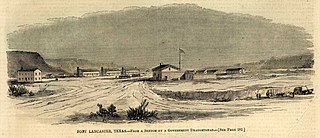
Fort Lancaster is a former United States Army installation located near Sheffield, Texas. The fort was established in 1855 on the San Antonio–El Paso Road to protect migrants moving toward California through Texas. The US Army occupied Fort Lancaster until Texas seceded from the United States in March 1861 and were replaced at the fort by forces loyal to the Confederate States of America. The Confederate Army held the fort from November 1861 until April 1862, when it was again abandoned and then burned.
The history of the United States Army began in 1775. From its formation, the United States Army has been the primary land based part of the United States Armed Forces. The Army's main responsibility has been in fighting land battles and military occupation. The Corps of Engineers also has a major role in controlling rivers inside the United States. The Continental Army was founded in response to a need for professional soldiers in the American Revolutionary War to fight the invading British Army. Until the 1940s, the Army was relatively small in peacetime. In 1947, the Air Force became completely independent of the Army Air Forces. The Army was under the control of the War Department until 1947, and since then the Defense Department. The U.S. Army fought the Indian Wars of the 1790s, the War of 1812 (1812–15), Mexican–American War (1846-1848), American Civil War (1861–65), American Indian Wars, Spanish–American War (1898), World War I (1917–18), World War II (1941–45), Korean War (1950–53) and Vietnam War (1965–71). Following the Cold War's end in 1991, Army has focused primarily on Western Asia, and also took part in the 1991 Gulf War and war in Iraq, and the war in Afghanistan.
United States Volunteers also known as U.S. Volunteers, U.S. Volunteer Army, or other variations of these, were military volunteers called upon during wartime to assist the United States Army but who were separate from both the Regular Army and the militia.

The 3rd Arkansas Field Battery (1860–1865) was a Confederate Army artillery battery from Pulaski County, Arkansas, during the American Civil War. The battery is also known as the Totten Light Artillery, Pulaski Light Artillery, the Weaver Light Artillery, Woodruff's Battery, and Marshall's Battery. The battery originated as a pre-war Militia company, initially enrolled in state service. After the Battle of Wilson's Creek, the battery was released from state service and eventually reorganized for Confederate Service. The battery provided the initial training for the leaders of numerous other Arkansas artillery batteries during the Civil War. The battery spent its entire service in the Department of the Trans-Mississippi.
The 1st Arkansas Light Artillery, originally known as the Fort Smith Artillery (1861), was an artillery battery of the Confederate States Army that served during the American Civil War. The unit was actually a pre-war volunteer militia company which was activated as part of the Arkansas State Troops and mustered out of state service following the Battle of Wilson's Creek. The unit immediately re-organized and re-enlisted for Confederate service. The unit spent the majority of the war in the western theater, fighting as part of the Confederate Army of Tennessee. The unit is also known as Reid's Battery, Provence's Battery, Humphreys' Battery and finally Rivers' Battery.

The Commemoration of the American Civil War on postage stamps concerns both the actual stamps and covers used during the American Civil War, and the later postage celebrations. The latter include commemorative stamp issues devoted to the actual events and personalities of the war, as well as definitive issues depicting many noteworthy individuals who participated in the era's crucial developments.

The 32nd Texas Cavalry Regiment, sometimes incorrectly named Andrews's 15th Texas Cavalry Regiment, was a unit of volunteer cavalry mustered into the Confederate States Army in May 1862 and which fought during the American Civil War. The regiment was formed around companies from Richard Phillip Crump's 1st Texas Cavalry Battalion which fought in Indian Territory and at Pea Ridge. Many of the soldiers died of disease in the unhealthy camps near Corinth, Mississippi. The cavalrymen were dismounted in July 1862 and served as infantry for the rest of the war. The regiment fought at Richmond, Ky., Stones River, and Chickamauga in 1862–1863, in the Meridian and Atlanta campaigns and at Nashville in 1864, and at Spanish Fort and Fort Blakeley in 1865. The regiment's 58 surviving members surrendered to Federal forces on 9 May 1865.
The 13th Texas Infantry Regiment was a unit of volunteers recruited in Texas that fought in the Confederate States Army during the American Civil War. The regiment organized between September 1861 and January 1862, and was originally called the 4th Texas Volunteer Regiment. It spent its entire existence patrolling the Texas Gulf Coast between Matagorda and Galveston. The unit was actually made up of infantry, cavalry, and artillery units, but was not designated a legion. In April 1862, four infantry companies transferred to the 15th Texas Infantry Regiment, while three cavalry and one artillery company transferred to Reuben R. Brown's 12th Texas Cavalry Battalion. In fall 1863, three additional infantry companies of the 13th Texas Infantry were added when the 12th Cavalry Battalion consolidated with Lee C. Rountree's Cavalry Battalion to form the 35th (Brown's) Texas Cavalry Regiment. The regiment's soldiers suffered from poor morale due to the lack of military action, disease, monotony, and lack of food. The troops were only involved in a few skirmishes with the United States Navy. The formal surrender date was in June 1865, but by that time most of the soldiers had returned home.
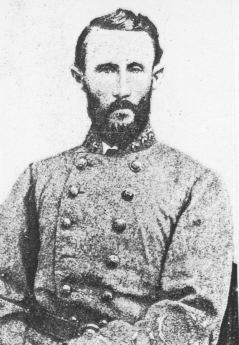
The 8th Texas Infantry Regiment was a unit of volunteers recruited in Texas that fought in the Confederate States Army during the American Civil War. In May 1862, the 8th Texas Infantry Battalion mustered into Confederate service in Refugio County, Texas, with three companies. A fourth company joined in June 1862 and a fifth company soon afterward. After training at Banquete, Texas, until July 1862, the battalion fought in the Battle of Corpus Christi where it defended that city. The full regiment was created when the 8th Infantry Battalion was joined by Shea's Artillery battalion, making 1 cavalry, 5 infantry, and 4 artillery companies. The regiment fought at Fort Esperanza in November 1863 and was transferred to east Texas soon afterward. At this time, many soldiers from the 8th Infantry transferred to Waul's Legion and fought in the Red River campaign. The regiment mustered out of service on 22 May 1865.
References
- ↑ Rochette, Patricia Adkins. 2006. Bourland in North Texas and Indian Territory during the Civil War, Fort Cobb, Fort Arbuckle & the Wichita Mountains. Broken Arrow, Okla.: privately published.
- ↑ Pickering, David, and Judy Falls. 2000. Brush Men and Vigilantes, Civil War Dissent in Texas. College Station, Tex.: Texas A&M Press.
- ↑ Smith, David Paul. 1992. Frontier Defense in Civil War, Texas Rangers and Rebels, 1861-1865. College Station, Tex.: Texas A&M Press.
- ↑ Rochette, 2006, op.cit.
- ↑ Pickering and Falls, 2000, op.cit.
- ↑ Smith, 1992, op.cit.